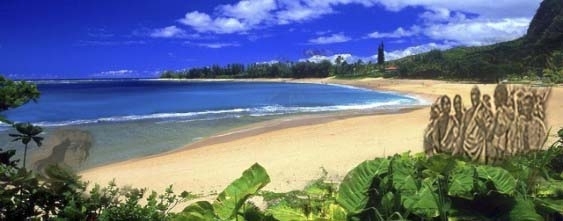Hawaii A Native Paradise
- Hawaii, United States
- Active & Adventure

| from $3,197* per person | 10 Days | November |
| Comfort accommodations | Exertion level: 3 | |
| Operator: Go Native America | 12 people max | |
With indigenous guides to lead your path through this tribal paradise, and the advice of the Kupuna (Hawaiian elders) echoing “take care of this land and the land will take care of you”, we explore Big Island, remembering this is a sacred place, or Wahi Kapu. Native Hawaiian advice is to allow yourself to be part of the landscape. Listen to the wind, rain, and birds; feel the heat of the steam and new land; and enjoy the smell of the forest, the sulphur, and of course the ocean.
In Hawaiian spirituality, the whale is an essence of the ocean, so we go with respect in search of the 40 ft hump-backed ballet dancers who winter in these tropical waters, courting and birthing their young. Hawaiian petroglyphs, legends, place names, and artifacts indicate the presence of the kohola in Hawaiian waters, and it is said that Hawaiians viewed the whale as such a sacred creature that information was kept secret and revealed to only a chosen few. The sight of whales breaching or slapping their tails on the water is something that will stay with you for life.
To the non-Hawaiian, the hula girls may seem a happy stereotype of island shangri-la, but the Hula was born of ancient Hawaii and is still a powerful means of sharing stories values and explanations, as well as everyday life. The dance, which may move to a chant, drum beats or lilting music, uses the body to tell a story; some hula celebrates pro-creation, others honor land and sea, flowers and cliffs and flowing lava. Hula depicts tales of tragic lovers, comic animals and petulant gods.
We take this opportunity to revel in the finest Hula festival on the Hawaiian islands - including art exhibits, craft fairs, demonstrations, performances, a parade that emphasizes the cultures of Hawaii, and a three-day hula competition that has received worldwide recognition for its historic and cultural significance.
Loading map, please wait...
Locations visited/nearby
Hawaii, United States
Special information
- This is a custom departure, meaning this trip is offered on dates that you arrange privately with the provider. Additionally, you need to form your own private group for this trip. The itinerary and price here is just a sample. Contact the provider for detailed pricing, minimum group size, and scheduling information. For most providers, the larger the group you are traveling with, the lower the per-person cost will be.
Itinerary
* At the Papahanaumokuakea Marine National Monument we learn how by Native traditions, the northwest Islands are considered a sacred place, a region of primordial darkness from which life springs and spirits return after death. The ocean played an important role to Native Hawaiians as it was used for resources and physical and spiritual sustenance in their everyday lives and poetically referred to as ke kai popolohua mea a Kāne (the deep dark ocean of Kāne).* The Hawaiian volcano goddess is considered one of the most intriguing and complicated deities in all of world mythology. Both creator and destroyer, known for her fiery passion and generosity, Pele’s story is endlessly fascinating. And these days, the plume of steam rising from Halemaumau Crater on the summit of Kilauea, shows that she is very much in residence at her traditional home. We travel to Hawaiian Volcanoes National Park - an ethereal landscape laden with lava tube caves, crevices of boiling magma, and moon-like crags of pahoehoe and ’a’a rocks—some of the youngest on Earth at this one of the world’s most active volcanoes. And immense Mauna Loa is the largest volcano in the world: over 130 Mount Everests could fit inside! Today, Hawaiians come to the park to dance hula and chant in honor of Pele, or to gather materials for traditional healing, ceremonies and crafts.
* At the Volcano Arts Center, we appreciate displays and explanations of traditional and modern Hawaiian Earth Arts. We meet traditional Hawaiian elders who will introduce us to simple healing uses for some of Hawaii’s most common native plant species as passed down from Auwae elders to their 'ohana. We learn traditional plant identification and protocols, with the Niaulani forest as the living classroom.
* History and culture are intertwined on this divine island of blissful views and genteel climate. At the restored ancient fishing village of Lapakahi you can almost see the spirits of the long-ago community, and at the historic Mookini Heiau (temple), birthplace of King Kamehameha the Great, we hear stories of Hawaiian culture from origin to contemporary. We stand before walls of lava rock, ‘reading’ stories and explanations carved in ancient petroglyphic languages, and experience the power of Puukohola Heiau, the 224-foot long by 100-foot wide stone heiau platform from which King Kamehameha united the islands.
More information from Go Native America:
- Email this trip page to a friend
-




Comments from Facebook